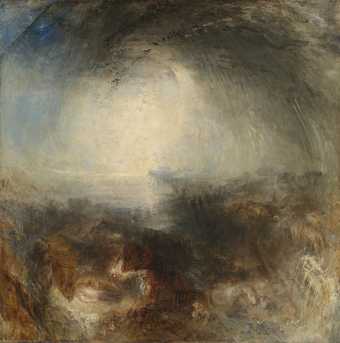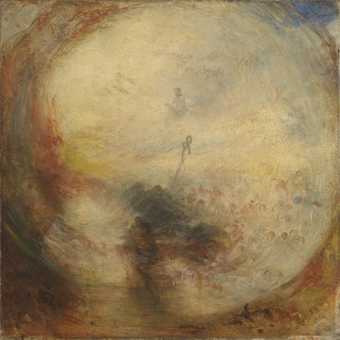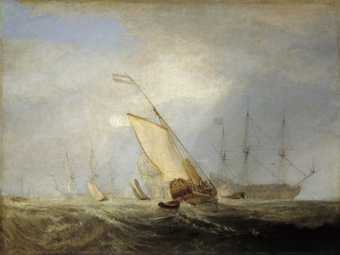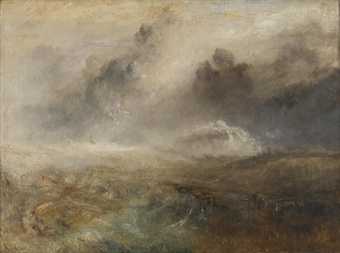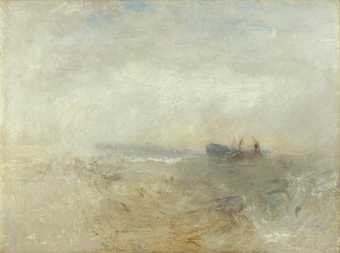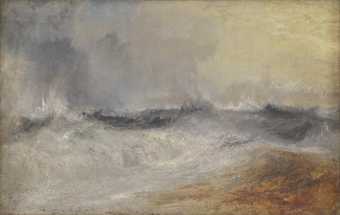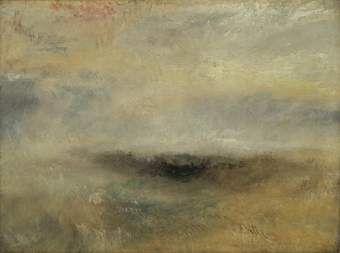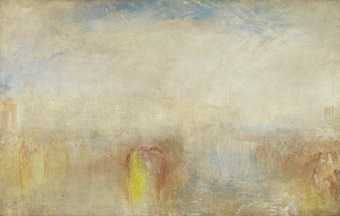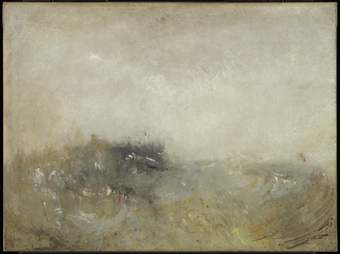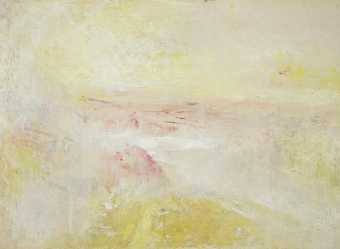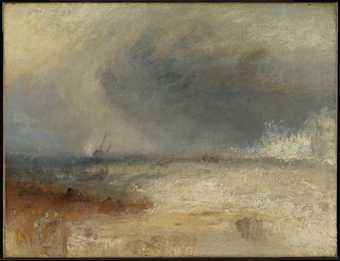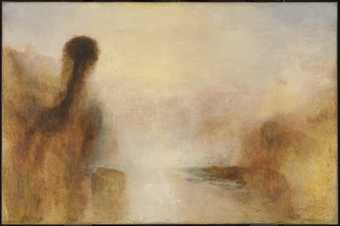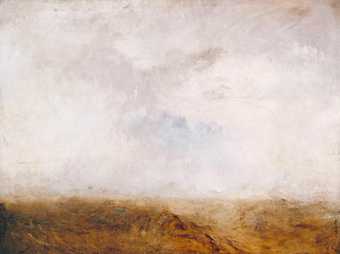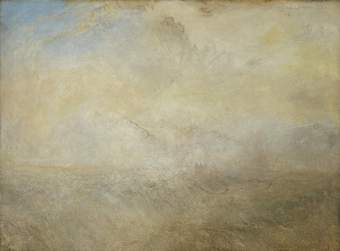
In Tate Britain
- Artist
- Joseph Mallord William Turner 1775–1851
- Medium
- Oil paint on canvas
- Dimensions
- Support: 914 × 1219 mm
frame: 1233 × 1535 × 145 mm - Collection
- Tate
- Acquisition
- Accepted by the nation as part of the Turner Bequest 1856
- Reference
- N00530
Display caption
In a contest of natural and mechanical energies, a steamboat battles a blizzard. It is taking soundings ‘by the lead line’ to determine the depth of water. The title specifies what is happening in precise nautical terms but Turner added some autobiographical narrative, claiming he experienced the storm. Later he said he had been lashed to the mast and had not expected to survive. There is no record of a steamboat called Ariel leaving Harwich in 1841–2 but a brig, Fairy, sank with all hands in November 1840.
Gallery label, November 2022
Does this text contain inaccurate information or language that you feel we should improve or change? We would like to hear from you.
Catalogue entry
398. [N00530] Snow Storm—Steam-Boat off a Harbour's Mouth making Signals in Shallow Water, and going by the Lead. The Author was in this Storm on the Night the Ariel left Harwich Exh. 1842
THE TATE GALLERY, LONDON (530)
Canvas, 36 × 48 (91·5 × 122)
Coll. Turner Bequest 1856 (10, ‘Steamer in a Snow Storm’ 4'0" × 3'0"); transferred to the Tate Gallery 1910, returned to the National Gallery 1952 and to the Tate Gallery 1968.
Exh. R.A. 1842 (182); Manchester 1887 (621); Amsterdam 1936 (163, repr.); Paris 1938 (146, repr.); New York, Chicago and Toronto 1946–7 (56, pl. 45); Venice and Rome 1948 (45); R.A. 1951–2 (163); New York, St Louis and San Francisco 1956–7 (115, repr. p. 16); New York 1966 (23, repr. in colour p. 44); R.A. 1974–5 (504, repr. in colour p. 504).
Lit. Ruskin 1843 and 1857 (1903–12, iii, pp. 297, 534, 569–71; xiii, pp. 161–3); Thornbury 1862, i, pp. 334–5, 347; ii, p. 207; 1877, pp. 407–8, 457–8, 466; Hamerton 1879, pp. 286–8; Monkhouse 1879, p. 128; Bell 1901, pp. 144–5 no. 233; Armstrong 1902, pp. 154–5, 231; Falk 1938, pp. 174–5; Clare 1951, pp. 106–7, repr. p. 108; Evans and Whitehouse 1956, p. 273; Davies 1959, pp. 98, 185; Finberg 1961, pp. 390, 506 no. 547; Herrmann 1963, p. 35; Kitson 1964, pp. 79, 82, repr. p. 68; Rothenstein and Butlin 1964, pp. 52–62, colour pl. xxi; Gowing 1966, pp. 38, 45–8, repr. in colour p. 44; Lindsay 1966, pp. 191, 255; Brill 1969, pp. 21–2, repr. p. 22; Gage 1969, pp. 39–40, 91; Reynolds 1969, p. 190, colour pl. 160; Gaunt 1971, p. 11, colour pl. 46; Watson 1971, p. 116; Gage 1972, p. 45, pl. 3; Herrmann 1975, pp. 50, 234, colour pl. 173; Adele Holcomb, ‘John Sell Cotman's Dismasted Brig and the Motif of the Drifiting Boat’, Studies in Romanticism xiv 1975, p. 38; Storch 1978, pp. 199–200; Wilton 1979, pp. 219–20, 228, pl. 228; Wilton 1980, pp. 99–100; Ziff 1980, p. 170; Charles Ninnis, ‘The Mystery of the Ariel’, Turner Society News no. 20, January 1981, pp. 6, 8, repr.; Paulson 1982, pp. 79, 82, 96.
The picture may recall a particularly bad storm in January 1842 though it has not been possible to tie down the exact incident. Despite Turner's title, no ship called Ariel is known to have been lost or involved in a storm in the years immediately preceding 1842, nor is any ship of that name known to have operated out of Harwich at this time. However, Charles Ninnis has suggested that Turner misremembered the name of the Fairy, which did set out from Harwich on 12 November 1840 and sank with all hands in a storm which began the following day and was still raging on 21 November, ‘the day on which the Princess Royal was born’, as the label on the back of No. 480 has it. Turner is not known to have been at Harwich at the time but could well have witnessed the storm at Margate where he often stayed with Mrs Booth.
In addition Adele Holcomb has cast doubts on the veracity of the story that Turner had himself tied to the mast for four hours during the storm; it does indeed bear a suspicious resemblance to accounts of the marine painter Joseph Vernet. However, in the fifth edition of his notes on the Turners on view at Marlborough House, Ruskin added a report of a conversation between the Rev. William Kingsley and Turner in which the artist stressed the truth of the incident and his interest in recording the experience: ‘I had taken my mother and a cousin to see Turner's pictures, and, as my mother knows nothing about art, I was taking her down the gallery to look at the large “Richmond Park”, but as we were passing the “Snowstorm” she stopped before it, and I could hardly get her to look at any other picture; she told me a great deal more about it than I had any notion of, though I have seen many sea storms. She had been in such a scene on the coast of Holland during the war. When, some time afterwards, I thanked Turner for his permission for her to see his pictures, I told him that he would not guess what had caught my mother's fancy, and then named the picture; and he then said, “I did not paint it to be understood, but I wished to show what such a scene was like; I got the sailors to lash me to the mast to observe it; I was lashed for four hours, and I did not expect to escape, but I felt bound to record it if I did. But no one had any business to like the picture.” “But,” said I, “my mother once went through just such a scene, and it brought it all back to her.” “Is your mother a painter?” “No.” “Then she ought to have been thinking of something else.” These were nearly his words; I observed at the time he used “record” and “painting” as the title “author” had struck me before’—see Turner's sub-title in the R.A. catalogue; Ruskin himself wrote ‘Note the significant use of this word, instead of “artist”’.
However, Ruskin records Turner's hurt reaction to the criticism (untraced) that the picture was nothing but a mass of ‘soapsuds and whitewash’: ‘Turner was passing the evening at my father's house on the day this criticism came out: and after dinner, sitting in his arm-chair by the fire, I heard him muttering to himself at intervals, “soapsuds and whitewash! What would they have? I wonder what they think the sea's like? I wish they'd been in it.”’ (Incidentally Frith, giving evidence at the Whistler versus Ruskin trial in 1878, attributed this criticism to Ruskin himself! See Ruskin, 1903–12, xxix, p. 584.) The Athenaeum's review on 14 May was typical of this abuse: ‘This gentleman has, on former occasions, chosen to paint with cream, or chocolate, yolk of egg, or currant jelly, —here he uses his whole array of kitchen stuff. Where the steam-boat is—where the harbour begins, or where it ends—which are the signals, and which the author in the Ariel...are matters past our finding out.’ Or, as the Art Union for 1 June observed, ‘Through the driving snow there are just perceptible portions of a steam-boat labouring on a rolling sea; but before any further account of the vessel can be given, it will be necessary to wait until the storm is cleared off a little. The sooner the better.’
In Modern Painters Ruskin described the Snowstorm, with two watercolours, as ‘nothing more than passages of the most hopeless, desolate, uncontrasted greys, and yet ... three of the very finest pieces of colour that have come from his hand’. Later, in a description of the effect of sea after prolonged storm he pointed out that ‘There is indeed no distinction left between air and sea; that no object, nor horizon, nor any land-mark or natural evidence of position is left ... Suppose the effect of the first sunbeam sent from above to show this annihilation to itself, and you have the sea picture of the Academy, 1842, the Snowstorm, one of the very grandest statements of sea-motion, mist, and light, that has ever been put on canvas, even by Turner. Of course it was not understood; his finest works never are...’
Published in:
Martin Butlin and Evelyn Joll, The Paintings of J.M.W. Turner, revised ed., New Haven and London 1984
Features
Explore
- abstraction(8,615)
-
- from recognisable sources(3,634)
-
- landscape(1,191)
- formal qualities(12,454)
-
- gestural(763)
- UK cities, towns and villages(12,725)
- Essex(278)
- England(19,202)
- England, East(1,353)
- transport: water(8,015)
-
- boat, steam(129)
You might like
-
Joseph Mallord William Turner Shade and Darkness - the Evening of the Deluge
exhibited 1843 -
Joseph Mallord William Turner Light and Colour (Goethe’s Theory) - the Morning after the Deluge - Moses Writing the Book of Genesis
exhibited 1843 -
Joseph Mallord William Turner Van Tromp Returning after the Battle off the Dogger Bank
exhibited 1833 -
Joseph Mallord William Turner Rough Sea with Wreckage
c.1840–5 -
Joseph Mallord William Turner A Wreck, with Fishing Boats
c.1840–5 -
Joseph Mallord William Turner Waves Breaking against the Wind
c.1840 -
Joseph Mallord William Turner Seascape with Storm Coming On
c.1840 -
Joseph Mallord William Turner Venetian Festival
c.1845 -
Joseph Mallord William Turner Stormy Sea with Dolphins
c.1835–40 -
Joseph Mallord William Turner Rough Sea
c.1840–5 -
Joseph Mallord William Turner Sunset From the Top of the Rigi
c.1844 -
Joseph Mallord William Turner Waves Breaking on a Shore
c.1835 -
Joseph Mallord William Turner Landscape with Water
c.1840–5 -
Joseph Mallord William Turner Seascape
c.1835–40 -
Joseph Mallord William Turner Seascape with Distant Coast
c.1840

